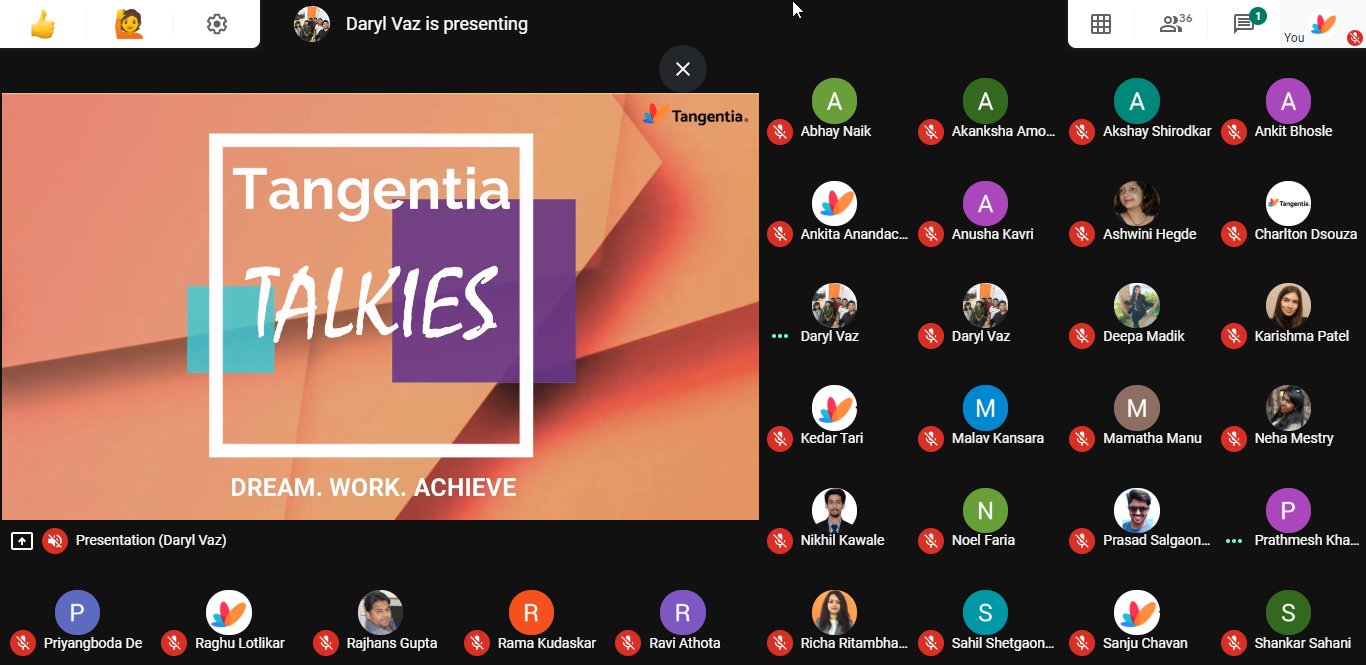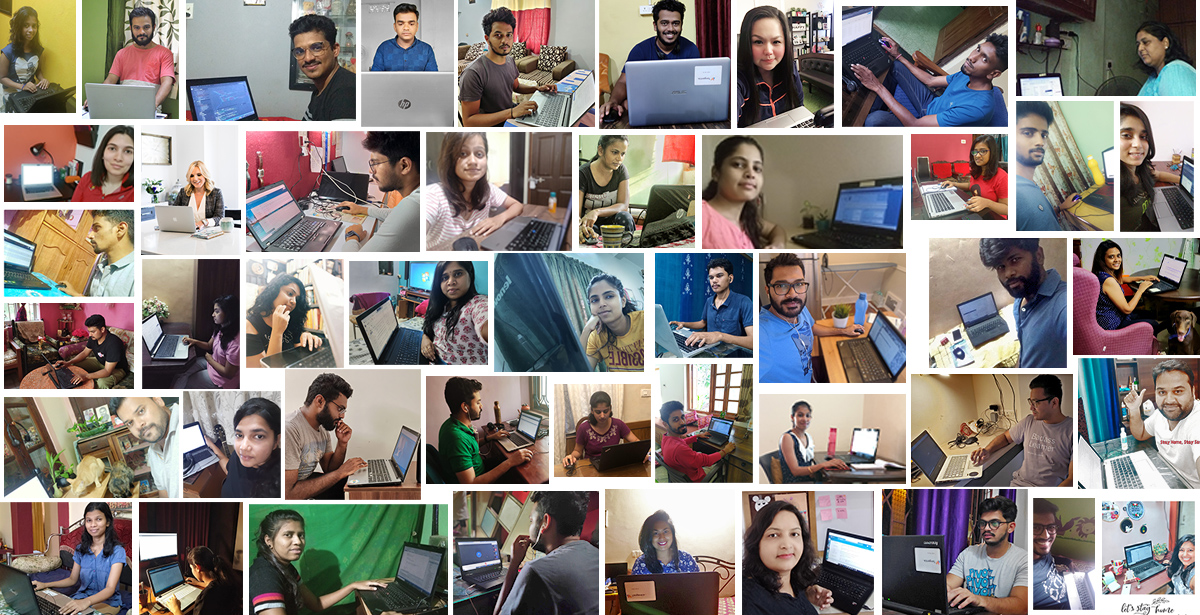

Monthly Tangentia Byte
April 2020
|
Staying Connected & Embracing RPA
|
|||||||||||||||||||||||||||||||||||||||||||||||||||||||||||||||||||||||||||
|
|||||||||||||||||||||||||||||||||||||||||||||||||||||||||||||||||||||||||||
If this pandemic has taught us all one thing, it is that the future is uncertain. And though there may be business disruptions, life and business must continue. This pandemic has also laid bare the unpreparedness of large industries and companies who have invested heavily in Information Technology, but the processes are still
largely manual.
And this has definitely affected customer experience and satisfaction . If we were to conduct a survey today, we would realize that customer experience is negatively affected. The reasons for customer dissatisfaction are mainly delay in response time, inadequate information and non-transparency. If RPA was deeply entrenched in the system, it would have enabled Banks and other financial service institutions to respond quickly and more efficiently to this new normal.
There are a few use cases for RPA in Banks. But these have so far been restricted to fraud detection and customer service to name a few. Some of the areas where RPA can provide immediate benefit can be as follows:
These are only a few areas where RPA can be integrated into the Bank’s processes.
a) The biggest benefit is that the employees can focus on their core competencies and leave mundane, repetitive tasks to the BOTs
b) RPA with a mix of Machine Learning can increase efficiency and accuracy in transactions and data entry
c) Implementation is quick due to availability of storefront like BOTs
d) RPA integrates with existing frameworks and systems and does not require a change in infrastructure
e) Change Management is easy and there are use cases where changes have been done in a matter of days
Banks are often looked at by governments as vehicles to add stability to the economy. This is also reflected in the large workforce most Banks carry. One of the biggest fears people have is that building a digital workforce will eliminate the need for a physical workforce.
That is not entirely true. The employees will instead be used for their core competencies. Employees will provide oversight, handle exceptions and take judgement calls based on experience. The goal of RPA is to improve operational
efficiency and not eliminate workforce.
So while a few Bank may have deployed chat-bots, the uptake has so far been slow. But now is the time when the banking industry must invest and build a digital workforce. It will not only improve efficiency and accuracy but also strengthen our defenses and readiness for the next disruption.
Watch our on-demand webinar to learn how financial institutions can quickly and easily implement RPA today with Tangentia and Automation Anywhere.
Tangentia is a Platinum Partner of IBM and well as partners with Automation Anywhere, UI Path, Blue Prism, Adobe, Microsoft, Salesforce, Amazon and leading enterprise software vendors. We work with customers globally with offices in Canada and India to implement their RPA strategies using an agile methodology.
Read Now
Everyone’s heard about Electronic Data Interchange (EDI) systems by now. But seamlessly integrating EDI data into an Enterprise Resource Planning (ERP) system is one area where many companies struggle. It’s important that these two systems communicate flawlessly to minimize processing times, eliminate errors, and avoid compliance issues.
Many companies rely on EDI systems that they struggle to maintain as they start to transition into the era of cloud technology. Most of them are legacy EDI systems that have been patched along over the decades, and trying to make them compatible with modern ERP systems is often a challenge.
So, how can you ensure that your EDI data is compatible with your ERP system? Let’s start by assessing the types of problems that most companies face when trying to integrate their EDI data with their ERP.
Let’s face it—incorporating your EDI data into your ERP system isn’t an easy task. Here are a few of the most common problems you’ll encounter:
Every organization is unique, and the challenges you face may be different. Still, your main focus should always be on maintaining the integrity and accessibility of the data that is essential to your business and your customers.
Several options exist when it comes to integrating your EDI data into an ERP system. The most popular options include:
Some companies use a Third-Party EDI Integration Plugin that acts as a bridge between their EDI and ERP systems. While this may prove successful for your organization, the cost associated with this option is typically high.
Third party EDI service providers not only ensure your EDI compliance with your trading partners’ EDI requirements, but they also typically offer ready-to-use integration modules for most ERPs. Many companies rely on Third Party EDI Service Providers to fully manage their overall EDI infrastructure, freeing them from costly in-house management and maintenance of these systems.
The more modern ERP, WMS and eCommerce platforms have started to embrace web services/API integration to allow their applications to seamlessly communicate with other applications. EDI data can be incorporated into your ERP by utilizing APIs.
Flat files are known as text database files. They are the most basic form of EDI data available. This method uses simple text files called flat-files (or CSV) to ensure data is compatible with the majority of ERP systems. Other EDI systems may use the XML format. These two file formats are the global standard in EDI and are highly-integratable with other ERP solutions.
Integrating your EDI data into an ERP system is a major process that every organization that handles huge amounts of data should consider. Tangentia specializes in fully integrated EDI solutions, and can help your company successfully build the bridge between your EDI, ERP, WMS, eCommerce and other business applications.
Tangentia has decades of experience working with EDI systems, and we understand exactly what it takes to build an automated system that is flexible, compliant, and functional while being cost-effective.
Get in touch with a member of the Tangentia team today to see how we can automate your EDI data flow between your existing business applications.
Tangentia is a Platinum Partner of IBM and well as partners with Automation Anywhere, UI Path, Blue Prism, Adobe, Microsoft, Salesforce, Amazon and leading enterprise software vendors. We work with customers globally with offices in Canada and India to implement their RPA strategies using an agile methodology.
Read Now
The closure of non-essential businesses and physical distancing mandates across the globe from COVID-19 has revealed an important challenge for organizations needing to quickly adopt a remote worker strategy. Over the course of a month businesses have had to quickly mobilize their in-office workforce with the tools they needed to work from home, while maintaining security and compliance. As leaders and internal teams were busy focusing on the “how” we also needed to pay close attention to our most critical asset – the people.
Organizations needed to ensure the mental well-being of its employees as they experience a major shift in their daily routines. Helping them stay engaged and motivated to ensure productivity and operational efficiencies, as best as possible. The unfortunate truth after a few weeks many remote employees started to feel the burden of isolation and missing the lack of in-person collaboration with their colleagues.
At Tangentia our team was already experienced in collaborating and working remotely with offices in both Canada and India and employees working onsite in Saudi Arabia and different parts of Canada but we realized we needed to do more. So we introduced a Remote Employee Engagement Program to tackle low morale and ensure everyone felt connected.
One initiative we launched is called –“Tangentia Talkies”
Tangentia Talkies is a daily session conducted on Google Hangout, which is presented by an employee for a short duration (10-15 minutes) with a Q&A period at the end. The format resembles a “talk show host” experience, which can be derived from the name itself (Tangentia Talkies). It begins with a theme song and continues with a presentation from the speaker. Once the presentation is over, the final credits are rolled, and everyone applauds the speaker and the listeners for their active participation in contributing to our collaborative culture.
The topic presented could be anything under the sun! The presenter could choose to educate the team on a topic they are passionate about, spread awareness for a cause or share a hidden talent with the team!

Some of the topics that have already been shared by the Tangentia team are Trust in the Digital Era which was presented by Rajhans Gupta(Sales Manager) wherein he spoke about the importance of trust and the effect it has on brands, ratings and protocols. The five main elements of trust and how companies can work on building trust among their consumers. Malav Kansara, Manager- Staffing presented on the “importance of Mental Health”. He presented a topic which is still considered a taboo with sensitivity and flair. He encouraged everyone to normalize this topic and seek help, if needed. You go to a doctor when you feel ill physically, the mind is no different- it also needs a specialist to heal.Priyanka Phadte, a trainee from the RPA vertical presented on “Parable” and encouraged everyone to think outside the box wherein the possibilities are infinite.She used animation in her presentation and showcased the different skills that she possessed. An otherwise shy and soft spoken- Shweta Kandri presented on the “Mystery called Dreams”. She explained a few famous theories on dreams like the Freudian Theory and the Modern theory and gave us a few interesting facts on dreams too.
The goal of the activity is to encourage open communication, maintain daily interaction with the team and eliminate the feeling of isolation – even if it’s for a short time.
The format resembles a “talk show host” experience, which can be derived from the name itself (Tangentia Talkies). It begins with a theme song and continues with a presentation from the speaker. Once the presentation is over, the final credits are rolled, after the HR department applauds the speaker and the listeners for their active participation in building our collaborative culture.

For businesses navigating these times of uncertainty the highest priority is often maintaining relationships and project success, but at Tangentia we work hard to find the balance between partners, projects and our people. We utilize collaboration tools such as Google Hangouts, Chat, WhatsApp and our phones to maintain open communication with our team.
We hope by sharing what we are doing at Tangentia during COVID-19, that it inspires other companies to implement similar programs, afterall we are all in this together.
#StayHome #FlattentheCurve
Tangentia is a Platinum Partner of IBM and well as partners with Automation Anywhere, UI Path, Blue Prism, Adobe, Microsoft, Salesforce, Amazon and leading enterprise software vendors. We work with customers globally with offices in Canada and India to implement their RPA strategies using an agile methodology.
Read Now
Compliance is a big issue for many companies, especially with the coming of the GDPR, SOX compliance, HIPAA, and more. Whether a company handles sensitive data or needs to meet strict regulations, maintaining compliance is a company-wide effort.
People often ask me whether robotic process automation (RPA) is a compliance-friendly solution. Perhaps they watched too many movies where robots become sentient and overthrow their human masters.
The simple answer is that RPA is one of the most compliance-friendly automation solutions on the market.
What makes RPA a compliance dream? Robots are programmed to perform specific tasks and nothing else.
Yes, we may one day see the rise of self-taught AI that can teach other AI, but that technology is many years away.
RPA solutions simply don’t go rogue. Their programming doesn’t support these kinds of actions. Instead, they focus on specific tasks. Bots will not share passwords—they won’t send emails in error or download potentially dangerous files. With the majority of bots the data is encrypted at rest as well as in flight so the bot never actually has access to the data they are interacting with.
The reality is that a company’s employees are far more likely to make compliance mistakes. This is why bots are far better to have in your IT infrastructure. Companies looking to build compliance systems should see bots as both a form of efficiency and security.
A company’s ability to maintain compliance is important for a variety of reasons. While legal fines are unfavorable, a complete erosion of customer trust is even more dangerous for a company.
According to Deloitte, “several aspects of compliance oversight operations can be enhanced through RPA implementation.”
But what advantages does RPA provide beyond eliminating simple human error? Based on my experience, here are a few of the main ones:
Competitive companies are already embracing RPA for the many advantages it has to offer. It’s clear automation will play a major role in the coming decades as companies look to improve their efficiency and build scalable systems that are aligned for growth.
While compliance is an important topic that companies should think about, RPA shouldn’t be seen as a problem. If anything, it’s the ideal solution to a problem that’s plagued companies for decades.
Where else can you find a repeatable solution that generates the same quality of results every time? From a compliance standpoint, bots are the way to go. As AI and machine learning continue to evolve, their capabilities will only grow.
Companies looking to improve their ability to maintain compliance, as well as their business operations, should see RPA as a logical solution.
Are you interested in learning more about RPA and how it can help your company stay compliant in the digital age? Get in touch with Tangentia, the leader in RPA solutions with local offices in Canada, America and India.
Tangentia is a Platinum Partner of IBM and well as partners with Automation Anywhere, UI Path, Blue Prism, Adobe, Microsoft, Salesforce, Amazon and leading enterprise software vendors. We work with customers globally with offices in Canada and India to implement their RPA strategies using an agile methodology.
Read Now